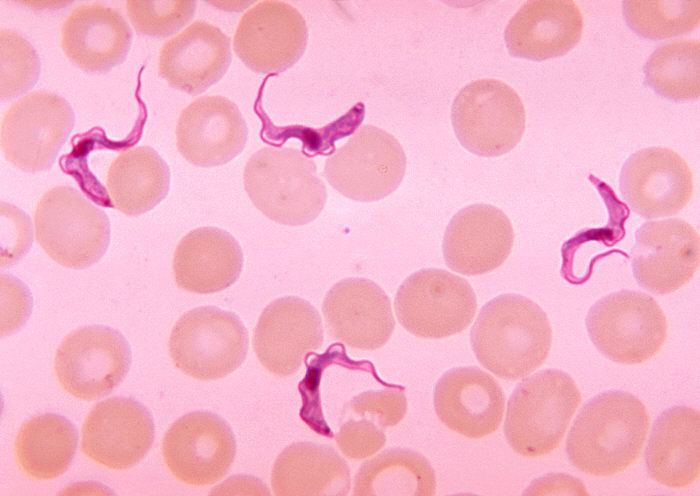Domain Eukaryota Scientific name Trypanosoma Higher classification Trypanosomatidae Order Trypanosomatida | Family Trypanosomatidae Rank Genus | |
 | ||
Lower classifications Trypanosoma brucei, Trypanosoma evansi, Trypanosoma congolense, Trypanosoma rangeli, Trypanosoma equiperdum | ||
Sleeping sickness by trypanosoma
Trypanosoma is a genus of kinetoplastids (class Kinetoplastida), a monophyletic group of unicellular parasitic flagellate protozoa. The name is derived from the Greek trypano- (borer) and soma (body) because of their corkscrew-like motion. Most trypanosomes are heteroxenous (requiring more than one obligatory host to complete life cycle) and most are transmitted via a vector. Some, such as Trypanosoma equiperdum, are spread by direct contact. The majority of species are transmitted by blood-feeding invertebrates, but there are different mechanisms among the varying species. In an invertebrate host they are generally found in the intestine, but normally occupy the bloodstream or an intracellular environment in the mammalian host.
Contents
- Sleeping sickness by trypanosoma
- History
- Taxonomy
- Evolution
- Selected species
- Hosts life cycle and morphologies
- References
Trypanosomes infect a variety of hosts and cause various diseases, including the fatal human diseases sleeping sickness, caused by Trypanosoma brucei, and Chagas disease, caused by Trypanosoma cruzi.
The mitochondrial genome of the Trypanosoma, as well as of other kinetoplastids, known as the kinetoplast, is made up of a highly complex series of catenated circles and minicircles and requires a cohort of proteins for organisation during cell division.
History
One of the first mentions of protozoans parasites of the blood was made by Valentin in 1841, who found flagellates (today included in Trypanoplasma) in the blood of trouts.
The genus (T. sanguinis) was named by Gruby in 1843, after parasites in the blood of frogs.
They were identified in mammals 50–80 years later.
Taxonomy
The monophyly of the genus Trypanosoma is not supported by a number of different methods. Rather, the American and African trypanosomes constitute distinct clades, implying that the major human disease agents T. cruzi (cause of Chagas’ disease) and T. brucei (cause of African sleeping sickness) are not closely related to each other.
Phylogenetic analyses suggest an ancient split into a branch containing all Salivarian trypanosomes and a branch containing all non-Salivarian lineages. The latter branch splits into a clade containing bird, reptilian and Stercorarian trypanosomes infecting mammals and a clade with a branch of fish trypanosomes and a branch of reptilian or amphibian lineages.
Salivarians are trypanosomes of the subgenera of Duttonella, Trypanozoon, Pycnomonas and Nannomonas. These trypanosomes are passed to the recipient in the saliva of the tsetse fly (Glossina spp.). Antigenic variation is a characteristic shared by the Salivaria, which has been particularly well-studied in T. brucei. The Trypanozoon subgenus contains the species Trypanosoma brucei, T. rhodesiense and T. equiperdum. The sub genus Duttonella contains the species T. vivax. Nannomonas contains T. congolense.
Stercorians are trypanosomes passed to the recipient in the feces of insects from the subfamily Triatominae (most importantly Triatoma infestans). This group includes Trypanosoma cruzi, T. lewisi, T. melophagium, T. nabiasi, T. rangeli, T. theileri, T. theodori. The sub genus Herpetosoma contains the species T. lewisi and the sub genus Schizotrypanum contains T. cruzi.
Evolution
The relationships between the species have not been worked out to date. It has been suggested that T. evansi arose from a clone of T. equiperdum which lost its maxicircles. It has also been proposed that T. evansi should be classified as a subspecies of T. brucei.
Selected species
Species of Trypanosoma include the following:
Hosts, life cycle and morphologies
Two different types of trypanosomes exist, and their life cycles are different, the salivarian species and the stercorarian species.
Stercorarian trypanosomes infect the insect, most often the triatomid kissing bug, develop in its posterior gut and infective organisms are released in the feces and deposited on the skin of the host. The organism then penetrates and can disseminate throughout the body. Insects become infected when taking a blood meal.
Salivarian trypanosomes develop in the anterior gut of insects, most importantly the Tsetse fly, and infective organisms are inoculated into the host by the insect bite before it feeds.
As trypanosomes progress through their life cycle they undergo a series of morphological changes as is typical of trypanosomatids. The life cycle often consists of the trypomastigote form in the vertebrate host and the trypomastigote or promastigote form in the gut of the invertebrate host. Intracellular lifecycle stages are normally found in the amastigote form. The trypomastigote morphology is unique to species in the genus Trypanosoma.
